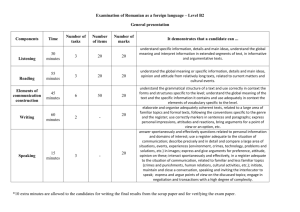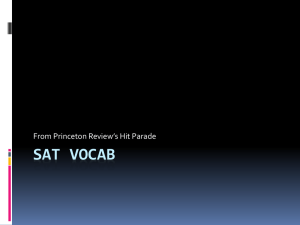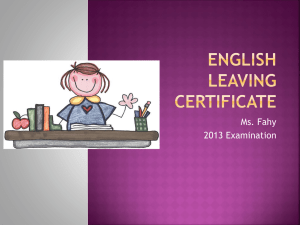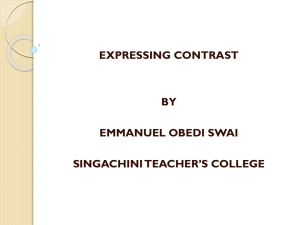General presentation
advertisement
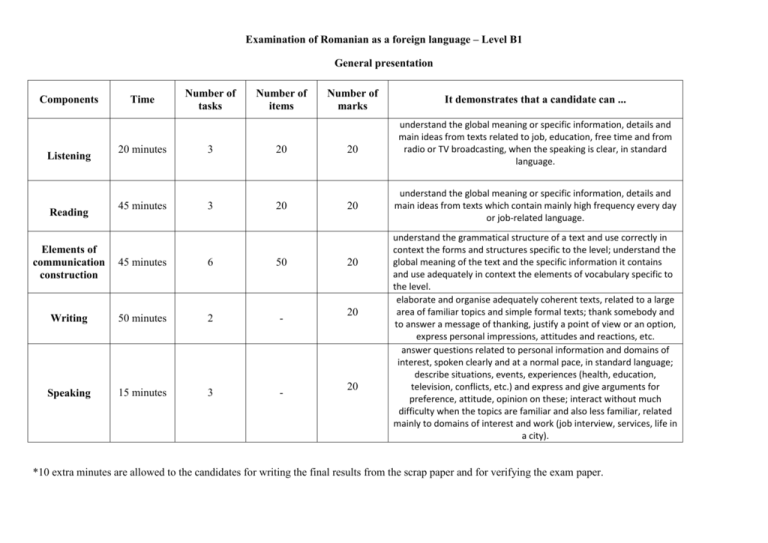
Examination of Romanian as a foreign language – Level B1 General presentation Components Listening Reading Time 20 minutes 45 minutes Number of tasks 3 3 Number of items 20 20 Elements of communication construction 45 minutes 6 50 Writing 50 minutes 2 - Speaking 15 minutes 3 - Number of marks 20 20 20 20 20 It demonstrates that a candidate can ... understand the global meaning or specific information, details and main ideas from texts related to job, education, free time and from radio or TV broadcasting, when the speaking is clear, in standard language. understand the global meaning or specific information, details and main ideas from texts which contain mainly high frequency every day or job-related language. understand the grammatical structure of a text and use correctly in context the forms and structures specific to the level; understand the global meaning of the text and the specific information it contains and use adequately in context the elements of vocabulary specific to the level. elaborate and organise adequately coherent texts, related to a large area of familiar topics and simple formal texts; thank somebody and to answer a message of thanking, justify a point of view or an option, express personal impressions, attitudes and reactions, etc. answer questions related to personal information and domains of interest, spoken clearly and at a normal pace, in standard language; describe situations, events, experiences (health, education, television, conflicts, etc.) and express and give arguments for preference, attitude, opinion on these; interact without much difficulty when the topics are familiar and also less familiar, related mainly to domains of interest and work (job interview, services, life in a city). *10 extra minutes are allowed to the candidates for writing the final results from the scrap paper and for verifying the exam paper. Examination of Romanian as a foreign language – Level B1 Content, structure, marking LISTENING Time Structure Task 1 20 de minute Task 2 Task 3 Type of text true/ false factual/ informative text; dialogue (texts from genuine sources, adapted according to the level) (250-300 words) gap filling factual/ informative text (texts from genuine sources, adapted according to the level) (250-300 words) multiple choice factual/ informative text, text segments or dialogue (texts from genuine sources, adapted according to the level) (250-300 words) Abilities understanding specific information and main ideas understanding and interpreting specific information and details; global understanding and interpretation of a text segment understanding specific information, of details and main ideas Number of items Modality of marking the correct answer Number of marks 8 writing the letters A or F in the numbered boxes 8 6 writing words in the corresponding boxes 6 6 circling 6 READING Time 45 minutes Structure Task 1 true/ false Task 2 multiple choice Task 3 gapped text Type of text argumentative, narrative, descriptive text, formal and informal correspondence) (250-400 words) argumentative, narrative, descriptive text, formal and informal correspondence) (250-400 words) argumentative, narrative, descriptive text, formal and informal correspondence) (250-400 words) Abilities understanding specific information and details; identifying main ideas; global understanding understanding specific information and details; identifying main ideas; global understanding understanding specific information and details; global understanding; apprehending text cohesion and coherence Number of items Modality of marking the correct answer Number of marks 8 writing the letters A or F in the numbered boxes 8 6 circling 6 6 writing the letter of the corresponding text segment in the numbered box 6 ELEMENTS OF COMMUNICATION CONSTRUCTION Time Domain Structure Task 1 Task 2 Grammar 45 minutes Vocabulary multiple choice gap filling (with the correct form of the given words) Task 3 gap filling (with words which are not given) Task 4 multiple choice Task 5 Task 6 Abilities gap filling (with words given in their correct form) derivation Number of items 10 the capacity of understanding the grammar structure of a text and of using correctly in context the grammatical forms and structures specific to the level the capacity of understanding the global meaning of the text and the specific information it contains and of using adequately in context the elements of vocabulary specific to the level Modality of marking the correct answer gap filling (corresponding letters) Number of marks 4 10 gap filling (words) 4 10 gap filling (words) 4 6 gap filling (corresponding letters) 2.4 6 gap filling (words) 2.4 8 gap filling words derived from the ones given in the column on the right 3.2 WRITING Time Structure Task 1 writing a text with an interactional pattern 50 minutes Task 2 writing a descriptive or narrative text Type of text informal correspondence (informative answers, recommendations, advice, thanks), semiformal letters (letters, emails or e-mail answers addressed to an official person, institution, company), publicity (towns and places in town, products and services, cultural activities) presentation (places, personalities), narration (travelling, events, plans, things which happened), simple essays (motivating options, expressing points of view related to familiar, concrete themes) Number of words 70 - 80 90 - 100 Abilities Modality of elaborating the answers Number of marks the capacity of elaborating and organising adequately coherent texts, related to a large area of familiar topics and simple formal texts; the capacity of thanking and answering to messages expressing thanking, of justifying a point of view or an option, of expressing personal impressions, attitudes and reactions, etc.; the capacity of giving advice on familiar matters; the capacity of using adequately elements of vocabulary and grammatical structures specific to the level elaboration of texts, based on detailed instructions in the rubrics and writing them in the available spaces; the candidate will consider all the details in the rubrics and/ or in the input 20 SPEAKING Time Structure Task 1 Task 2 conversation with the examiner questions related to personal information, addressed by the examiner (job, studies, house, travelling, etc.) monologue images related to familiar topics (education, media, means of communication, travelling, etc.), accompanied by detailed written rubrics 15 minutes Task 3 Type of input dialogue detailed written rubrics; the dialogue will be based on familiar and less familiar themes related mainly to domains of interest and work (services, life in the countryside, life in a city) Number of minutes 2 minutes 3 minutes 4 minutes (for both candidates) Abilities the capacity of answering questions related to personal information and domains of interest, spoken clearly and at a normal pace, in standard language the capacity of describing and comparing situations, events, experiences (health, education, television, conflicts, etc.) presented in images, and of expressing and giving arguments for preference, attitude, opinion about these the capacity of interacting without much difficulty, in relation to familiar and less familiar topics, related mainly to domains of interest and work (job interview, services, life in a city) Communicative functions Number of marks greeting; giving personal information; indicating that the message was not understood/ asking for a question to be repeated; self-correction; approximating; giving examples; narrating; arguing in a simple way description of situations, events and experiences; comparison between situations or persons; expressing and motivating attitude/ preference/ interest; expressing and motivating opinion 20 greeting; initiating and maintaining a conversation; asking for and offering information, explaining, expressing opinion; expressing preference, wish, likes/ dislikes; indicating that the message was not understood; asking for clarification; expressing probability; giving examples; asking for/ offering and accepting/ rejecting a suggestion; announcing a fact; expressing surprise/ admiration/ impatience; asking for/ offering directions, instructions; expressing interdiction; asking for permission; circumlocution; expressing agreement/ disagreement
